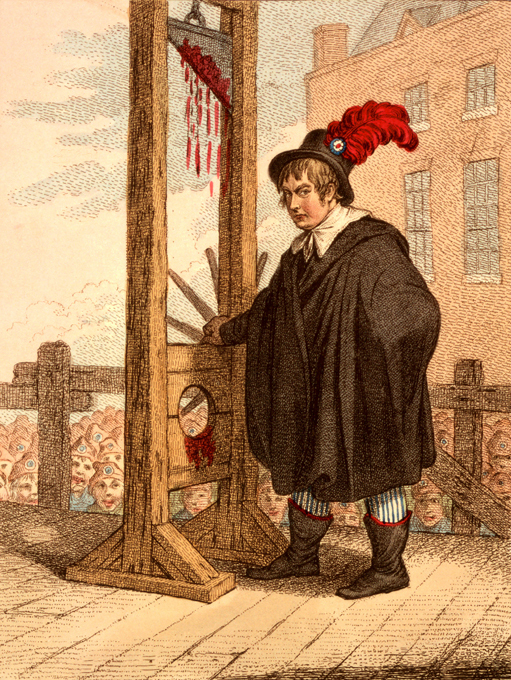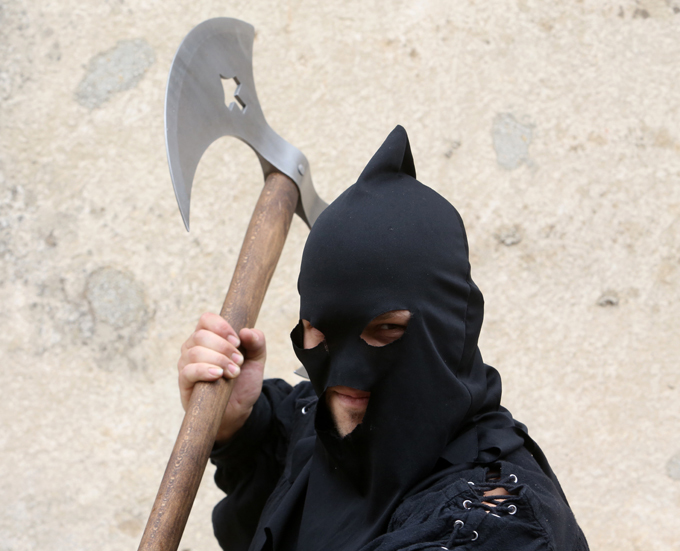Executioner as a profession

The executioner was usually presented with a warrant authorizing or ordering him to execute the sentence. The warrant protects the executioner from the charge of murder
The executioner was usually presented with a warrant authorizing or ordering him to execute the sentence. The warrant protects the executioner from the charge of murder

Many executioners were professional specialists who traveled a circuit or region performing their duty, because executions would rarely be very numerous. Within this region, a resident executioner would also administernon-lethal physical punishments, or apply torture.
Many executioners were professional specialists who traveled a circuit or region performing their duty, because executions would rarely be very numerous. Within this region, a resident executioner would also administernon-lethal physical punishments, or apply torture.

The profession of executioner sometimes ran through a family, especially in France where the Sanson family provided six executioners between 1688 and 1847, and the Deibler dynasty provided five between 1879 and abolition in 1981 (Louis Deibler, his son Anatole, Anatole's nephew Jules-Henri Desfourneaux, another nephew of Anatole, André Obrecht, and finally André's nephew, Marcel Chevalier).
The profession of executioner sometimes ran through a family, especially in France where the Sanson family provided six executioners between 1688 and 1847, and the Deibler dynasty provided five between 1879 and abolition in 1981 (Louis Deibler, his son Anatole, Anatole's nephew Jules-Henri Desfourneaux, another nephew of Anatole, André Obrecht, and finally André's nephew, Marcel Chevalier).

The same for Germany where executioners were obliged to train their sons for the job as future executioners. Descendants of executioners would anyway not be entitled to chose any other profession than that of an executioner, and the rare exceptions to exist would only happen after long and complicated lawsuits. Executioners could only marry women from executioner families.
The same for Germany where executioners were obliged to train their sons for the job as future executioners. Descendants of executioners would anyway not be entitled to chose any other profession than that of an executioner, and the rare exceptions to exist would only happen after long and complicated lawsuits. Executioners could only marry women from executioner families.

To touch an executioner or anything he had ever touched transmitted the executioner's uncleanness onto the person who did so, and a pastor would have to perform a purification ritual to turn that person clean again. Therefore, most churches and pubs would not let an executioner in, unless they'd have a special seat apart from the others, and pubs with a seat for the executioner would have a special glass chained to the separate table
To touch an executioner or anything he had ever touched transmitted the executioner's uncleanness onto the person who did so, and a pastor would have to perform a purification ritual to turn that person clean again. Therefore, most churches and pubs would not let an executioner in, unless they'd have a special seat apart from the others, and pubs with a seat for the executioner would have a special glass chained to the separate table

The lack of social shunning for executioners in places like North America may be attributed to the infrequency of executions in modern times and the ease in which prison or judicial officials are able to conceal their daily job duties. This provides anonymity that was not possible when executions were carried out in view of the general public.
The lack of social shunning for executioners in places like North America may be attributed to the infrequency of executions in modern times and the ease in which prison or judicial officials are able to conceal their daily job duties. This provides anonymity that was not possible when executions were carried out in view of the general public.

In Japan, executioners have been held in contempt as part of the Burakumin class (today executions in Japan are not carried out by professional executioners, but by prison guards regularly moved). In "Memories of Silk and Straw", by Junichi Saga, one of the families surveyed in the Japanese village of Tsuchiura is that of an executioner family. This family does suffer social isolation, even though the family is somewhat well-off financially
In Japan, executioners have been held in contempt as part of the Burakumin class (today executions in Japan are not carried out by professional executioners, but by prison guards regularly moved). In "Memories of Silk and Straw", by Junichi Saga, one of the families surveyed in the Japanese village of Tsuchiura is that of an executioner family. This family does suffer social isolation, even though the family is somewhat well-off financially

In the Ottoman Empire, only gypsies could be executioners. Executioners were seen as "damned" people and even their graveyards were separate from public graveyards. There were no inscriptions on executioner tombstones, usually uncarved and unpolished simple rough stones were used.
In the Ottoman Empire, only gypsies could be executioners. Executioners were seen as "damned" people and even their graveyards were separate from public graveyards. There were no inscriptions on executioner tombstones, usually uncarved and unpolished simple rough stones were used.

One of the oldest and largest "executioner graveyards" is in the Eyüp district in Istanbul. After the republican revolution in Turkey, executions continued to be performed by gypsy executioners. This situation continued until the abolition of capital punishment in Turkey.
One of the oldest and largest "executioner graveyards" is in the Eyüp district in Istanbul. After the republican revolution in Turkey, executions continued to be performed by gypsy executioners. This situation continued until the abolition of capital punishment in Turkey.



